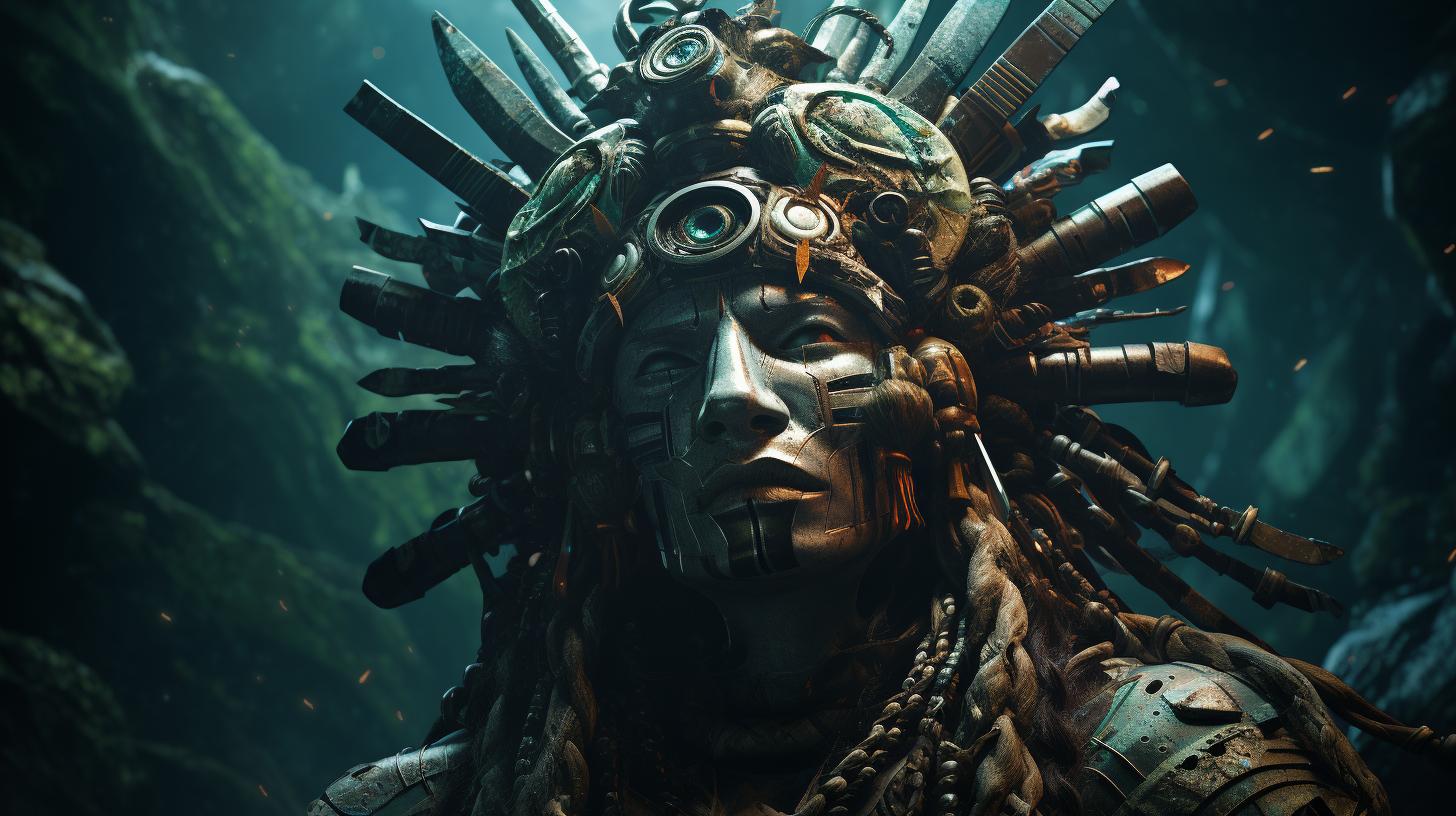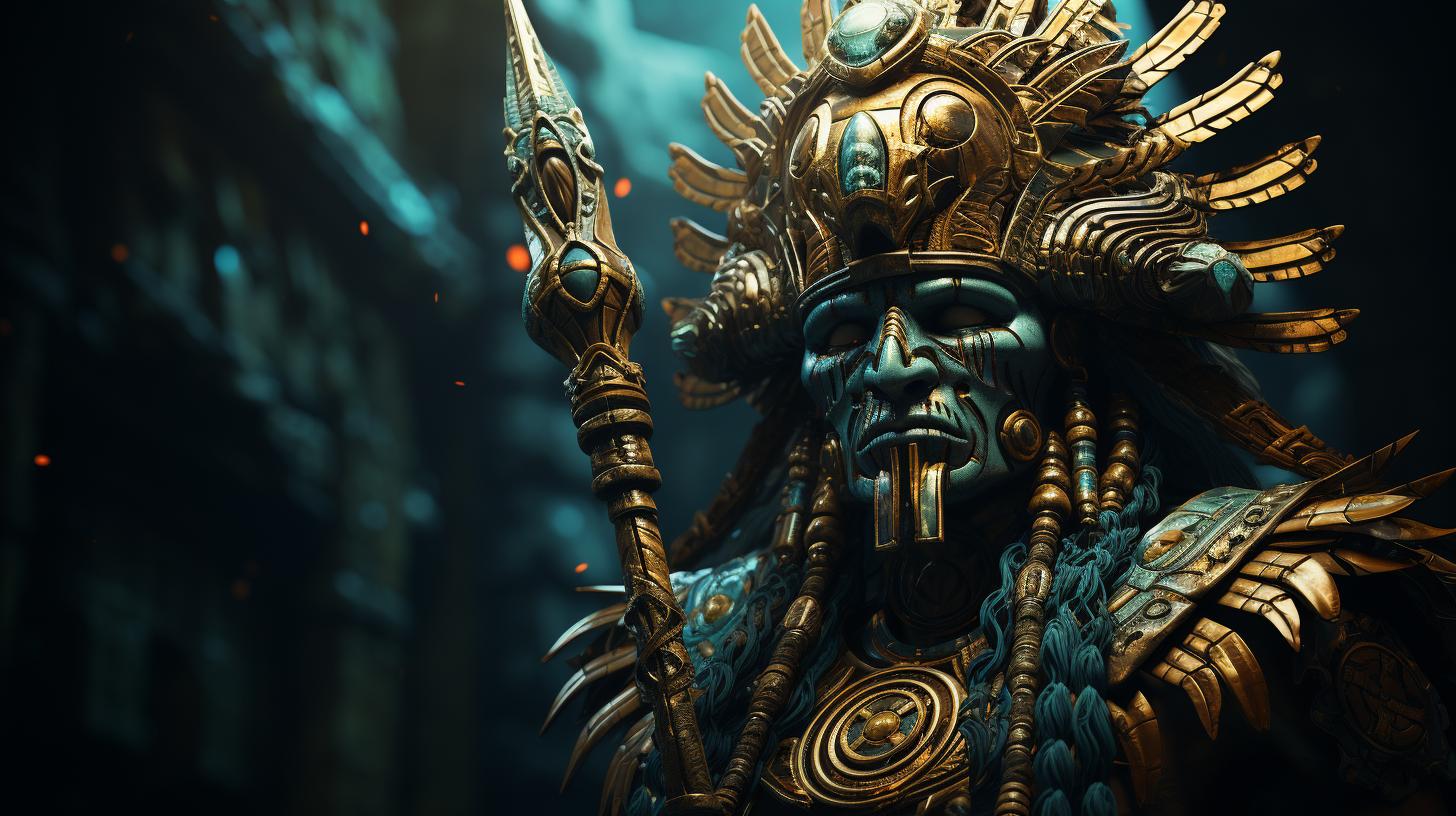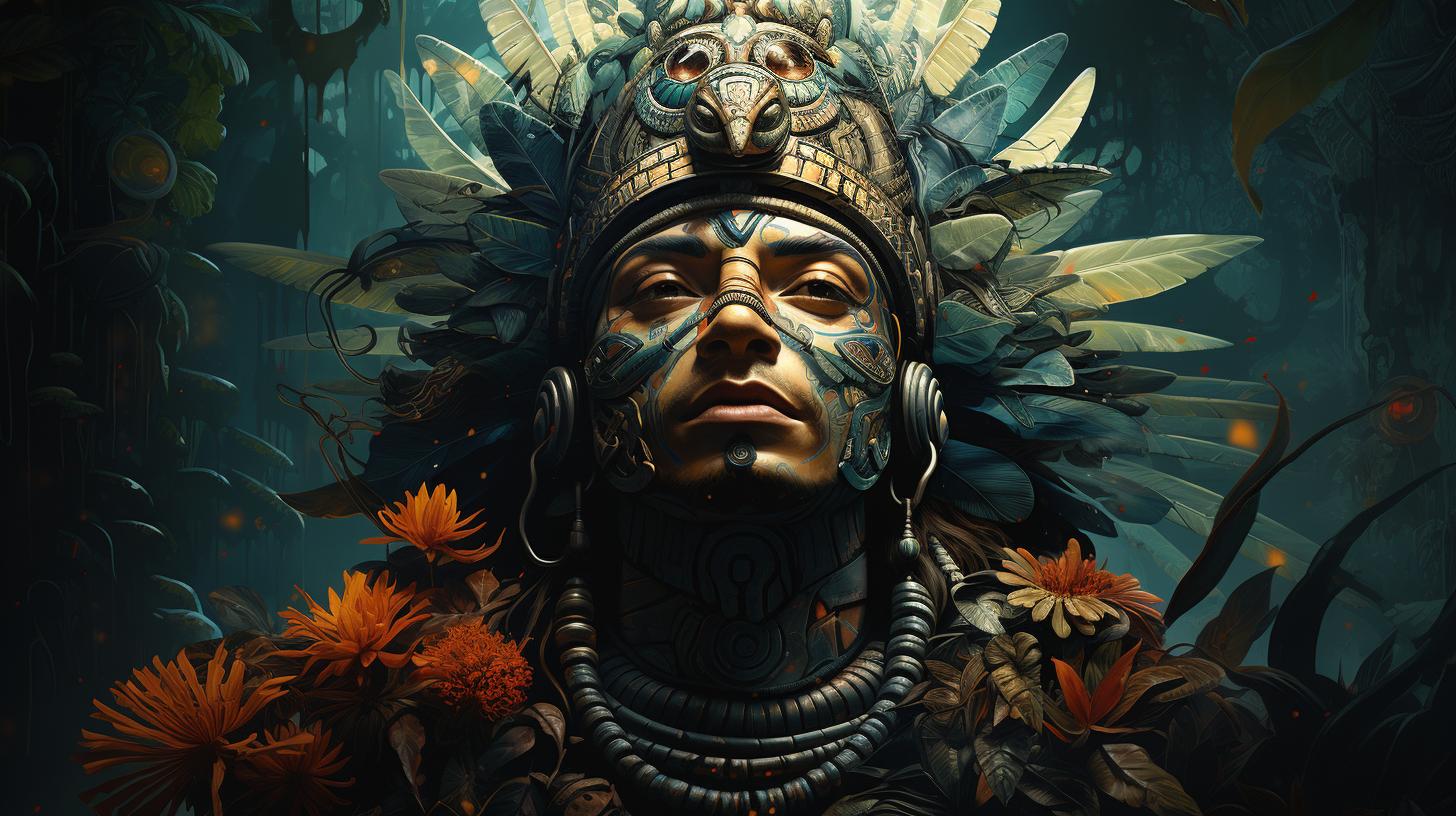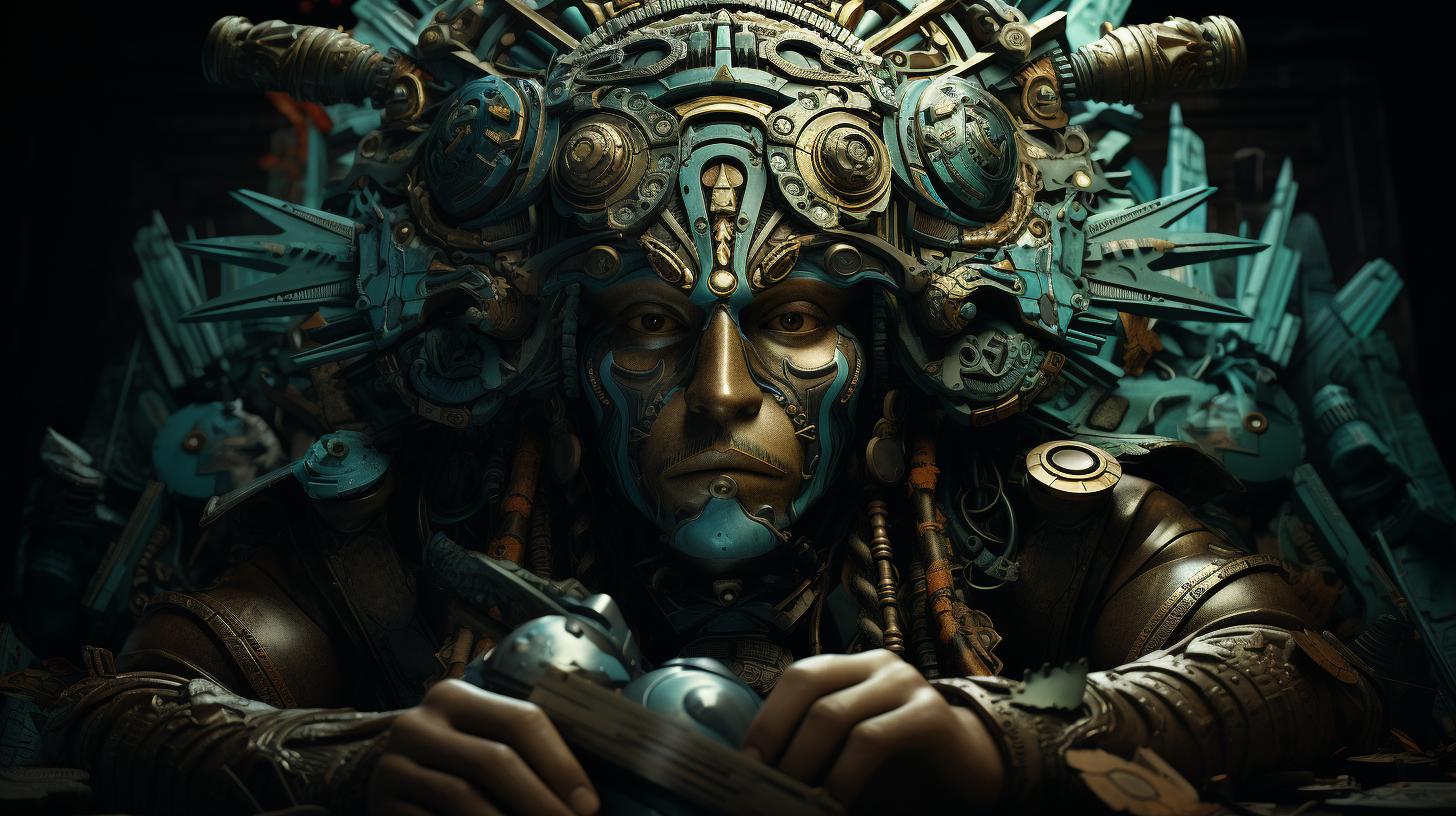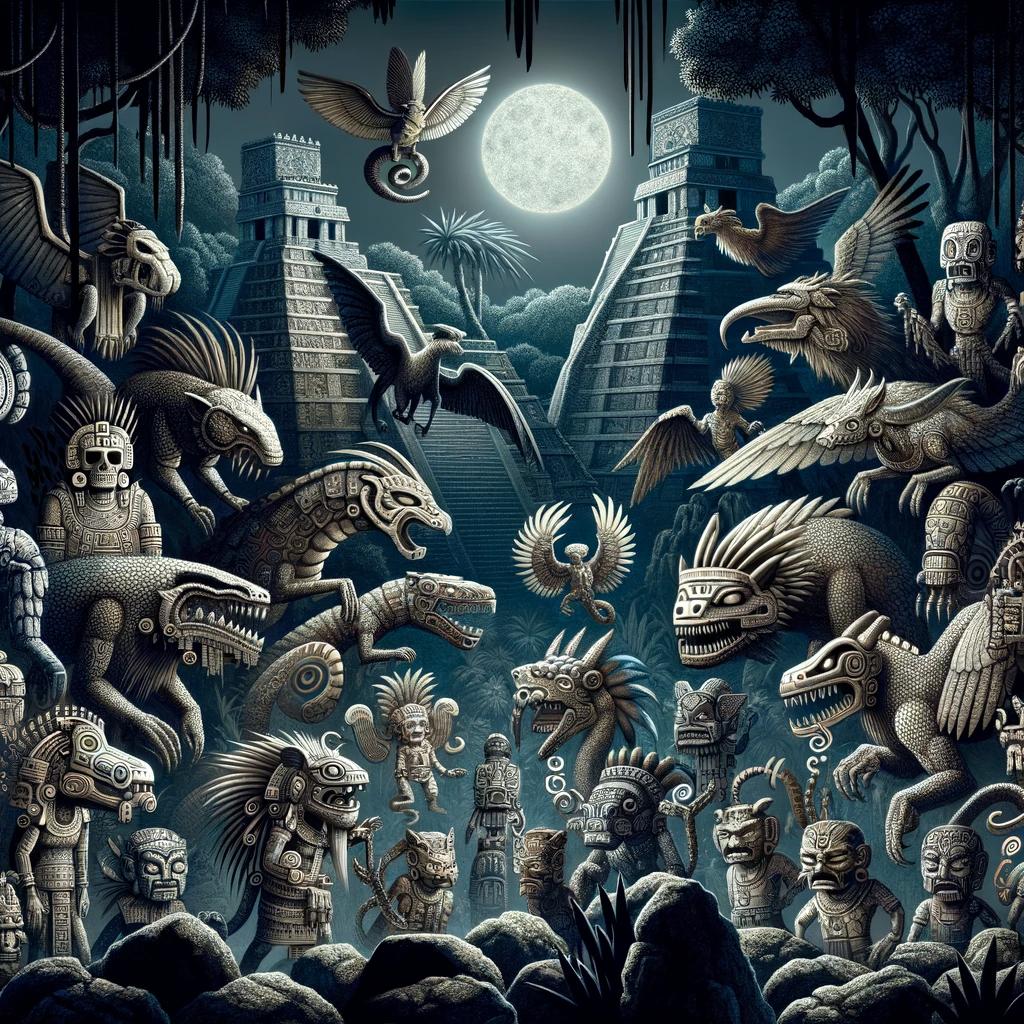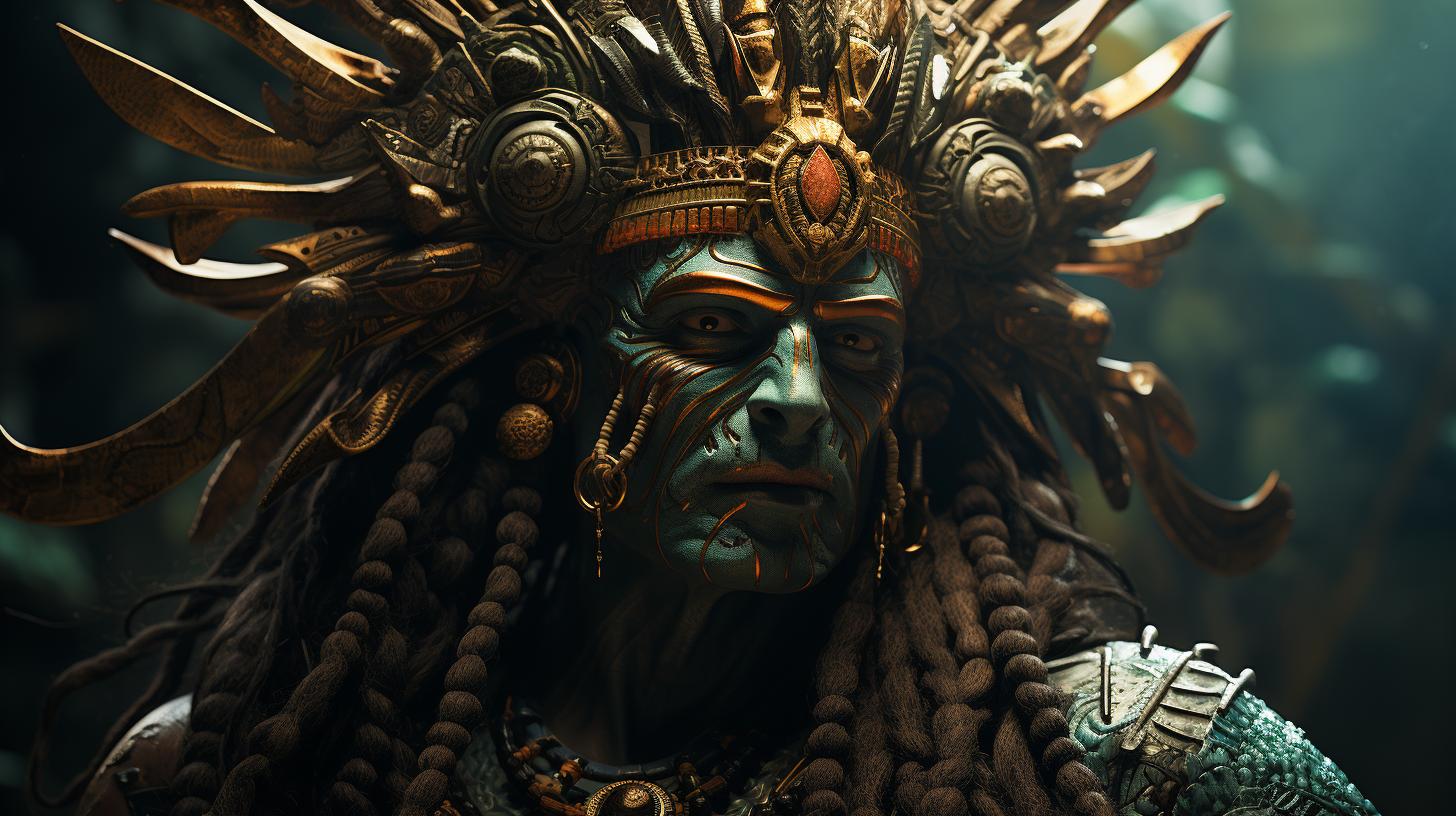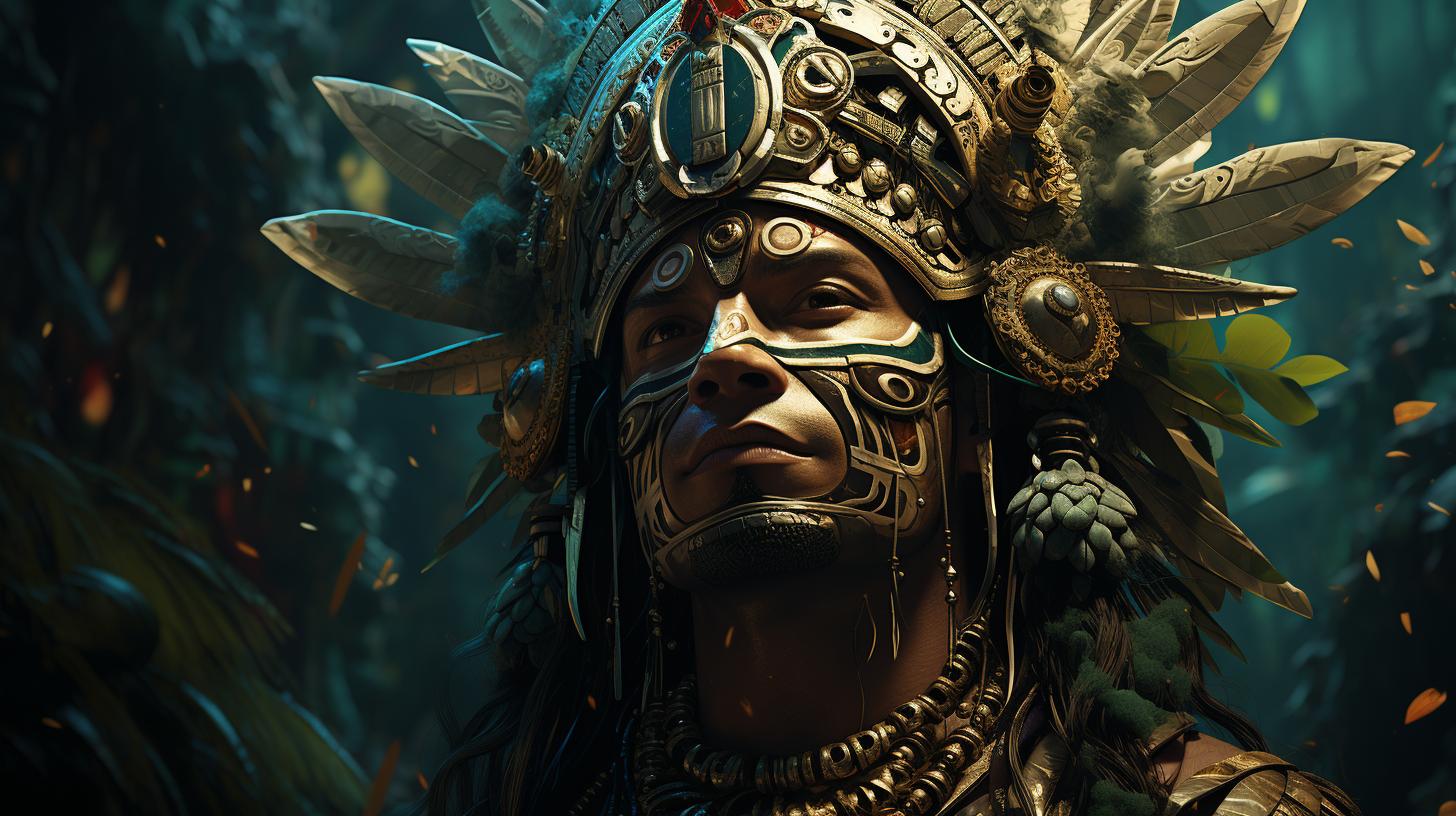Tepeu and Gucumatz: Unveiling the Mayan Creation Myth
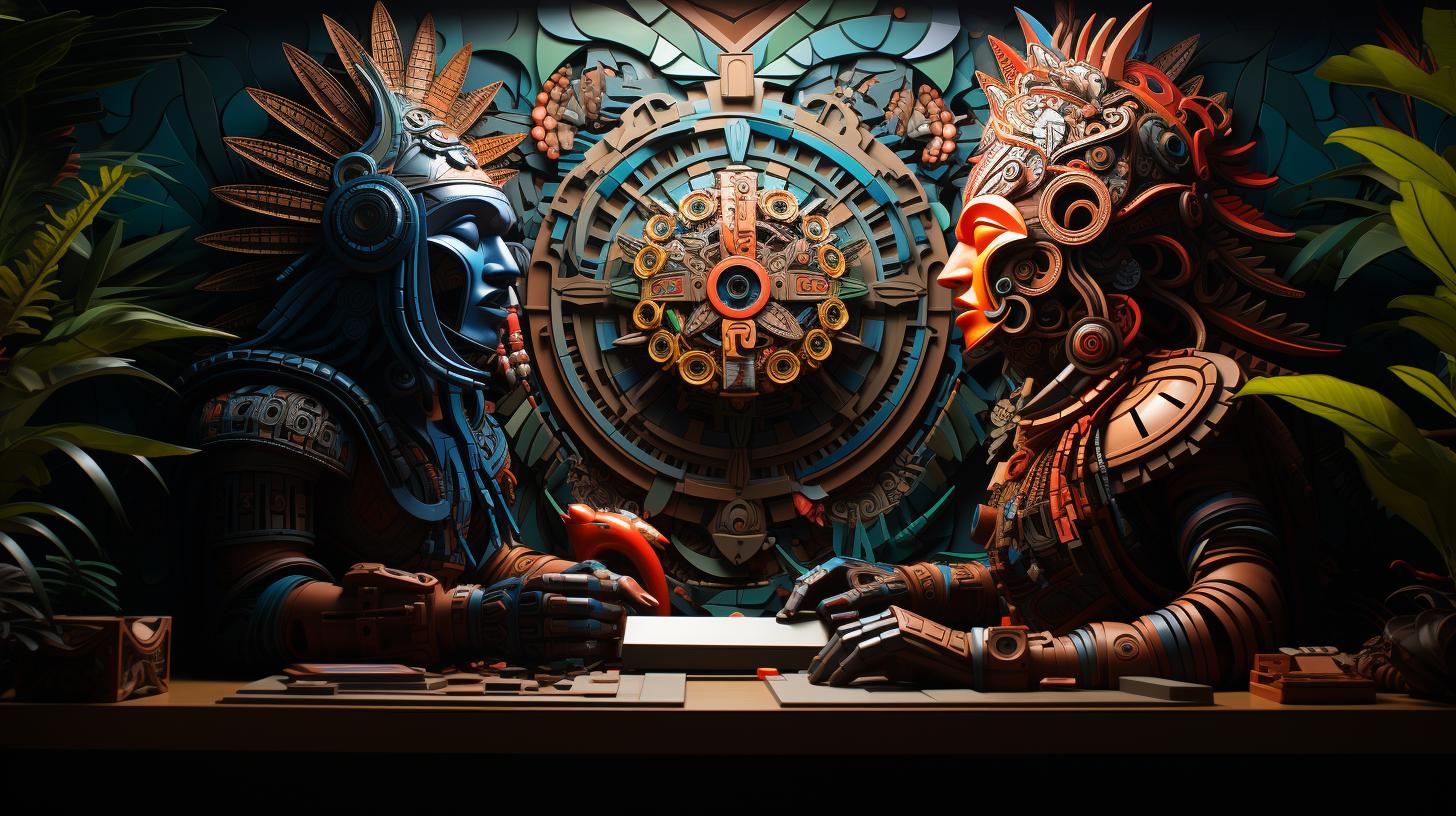
The article delves into the Mayan creation myth, with a specific focus on Tepeu and Gucumatz. These mythical figures hold great significance in Mayan cosmology and their story is explored within the broader context of the Pantheon of Mayan Gods.
The Popol Vuh, a crucial text for understanding Tepeu and Gucumatz, is discussed alongside their representation in Mayan art. The influence of Tepeu and Gucumatz in modern culture is also examined, shedding light on their enduring popularity.
Ongoing research and unanswered questions surrounding these mythical beings are highlighted.
Unraveling the Mayan Creation Myth
In this section, we will delve into the intriguing and complex world of the Mayan creation myth. Our exploration begins with the captivating myth of Tepeu and Gucumatz, two significant figures in Mayan cosmology.
The Myth of Tepeu and Gucumatz
The myth of Tepeu and Gucumatz tells a mesmerizing tale of cosmic creation. According to Mayan belief, Tepeu and Gucumatz were divine beings who played a pivotal role in shaping the world as we know it.
They brought forth life and established the foundation of the natural and spiritual realms.
Together, Tepeu and Gucumatz embarked on a mystical journey, using their divine powers to shape the elements of the universe.
Their harmonious collaboration gave birth to the land, the mountains, and the vibrant tapestry of life that inhabits our Earth today.
Significance of Tepeu and Gucumatz in Mayan Cosmology
Tepeu and Gucumatz hold deep significance within Mayan cosmology. They are revered as creator deities who bridged the gap between the celestial and earthly realms. Their divine actions were seen as divine interventions, shaping the very essence of existence.
Tepeu and Gucumatz’s creative powers and their ability to manifest life symbolize the Mayan belief in the interconnectedness of all living beings. They represent the profound relationship between the spiritual and natural world, emphasizing the importance of harmony and balance in the cosmic order.
Throughout Mayan history, their myth has played a crucial role in shaping cultural practices and religious rituals. The legacy of Tepeu and Gucumatz continues to resonate among the Mayan people, serving as a reminder of the enduring power of creation and the sacred bond between humanity and the divine.
As we embark on this exploration of the Mayan creation myth, we will uncover more fascinating aspects of Tepeu and Gucumatz’s story, as well as their roles within the broader Pantheon of Mayan Gods.
Join us as we unravel the secrets of this mystical narrative and gain a deeper understanding of Mayan cosmology.
Stay tuned for the upcoming sections:
- Exploring the Itzamná Mayan God
- Understanding the Cabrakan Mayan God
- The Pantheon of Mayan Gods
- The Popol Vuh and Its Role in Understanding Tepeu and Gucumatz
- Delving into the Deep Symbolism of Tepeu and Gucumatz
- Decoding the Popularity and Influence of Tepeu and Gucumatz in Modern Culture
- Unanswered Questions and Ongoing Research on Tepeu and Gucumatz
Continue your journey into the heart of Mayan mythology with us as we uncover the mysteries of Tepeu and Gucumatz’s creation myth.
Exploring the Itzamná Mayan God
The Itzamná Mayan god holds a significant place in Mayan mythology and cosmology. Regarded as one of the most important deities, Itzamná is associated with various aspects of life and the natural world.
Let’s delve into the significance and attributes of Itzamná.
Itzamná is considered the supreme god and the creator of the universe in Mayan cosmology. He is often depicted as an elder figure with a long white beard, symbolizing wisdom and authority.
Itzamná is associated with the sun, rain, and agriculture, making him a vital deity for the Mayan civilization’s sustenance and prosperity.
As the god of writing and knowledge, Itzamná is closely linked to the development of written language, hieroglyphs, and the recording of historical events. In this role, he is also associated with divination, astrology, and interpreting celestial phenomena, which were crucial for understanding the world and predicting future events.
Itzamná is believed to reside in the heavens or the celestial realm, maintaining balance and order in the cosmos. He is often associated with the bird-like creature known as the ceiba tree deity, which symbolizes the connection between the earthly and celestial realms.
The worship of Itzamná played a significant role in Mayan society. Rituals and ceremonies were dedicated to honoring this deity and seeking his blessings for a bountiful harvest, fertility, and protection from disasters.
Itzamná was revered as the protector of the Mayan people, their crops, and their health.
The influence of Itzamná can be found in various artifacts, sculptures, and murals discovered in Mayan archaeological sites. These artworks depict his prominent presence and highlight his role as a central figure in the Mayan pantheon.

In conclusion, exploring the Itzamná Mayan god sheds light on the rich mythology and religious beliefs of the Mayan civilization. Itzamná’s significance as the creator, protector, and source of knowledge underscores his importance in Mayan cosmology, offering a glimpse into the profound spiritual connection between the ancient Maya and the natural world.
Understanding the Cabrakan Mayan God
The Cabrakan Mayan God, also known as the Earthquake God, holds a significant place in Mayan mythology. This powerful deity is associated with seismic activity and represents the destructive forces of nature.
According to Mayan beliefs, Cabrakan was responsible for the creation of mountains and valleys through his earth-shaking movements. It is believed that his footsteps caused earthquakes and volcanic eruptions, shaping the landscape of the world.
In Mayan art and iconography, Cabrakan is often depicted as a hulking figure with bulging muscles and a fierce expression. He is shown with jagged rocks protruding from his back, symbolizing the strength of the earth’s crust.
Sometimes, he is depicted with a club or a large boulder, representing his destructive capabilities.
The role of Cabrakan in Mayan cosmology was complex. While he was associated with destruction, his actions were seen as necessary for the renewal and transformation of the world.
The Mayans believed that the cycle of creation and destruction was essential for maintaining the balance of the cosmos.
Moreover, Cabrakan’s powers transcended the physical realm. He was also associated with the underworld, where he played a role in the realm of the dead.
Some Mayan legends depict him as a guardian of the underworld, ensuring that the souls of the deceased find their proper place.
Understanding the significance of Cabrakan in Mayan mythology provides valuable insights into the belief system and worldview of the ancient Mayan civilization.
His representation as both a destructive force and a necessary agent of change reflects the Mayan understanding of the cyclical nature of existence.
The Pantheon of Mayan Gods
The ancient Maya believed in a diverse pantheon of gods and goddesses, each with their own unique characteristics and powers. These deities played central roles in Mayan mythology and were worshiped by the Mayan people in various rituals and ceremonies.
Through the study of Mayan art, literature, and religious texts, we can gain insights into the rich tapestry of the Mayan pantheon.
Overview of Mayan Deities
The Mayan pantheon consisted of numerous deities, representing various aspects of the natural world, celestial entities, and supernatural forces. They were often associated with specific elements, such as the sun, moon, rain, agriculture, and fertility.
Some gods embodied both positive and negative qualities, reflecting the duality of existence in Mayan cosmology.
The Mayan deities had complex relationships with one another, and their interactions influenced the creation of the world, the cycles of life and death, and the overall balance of the cosmos.
The actions and characteristics of these gods served as moral and spiritual lessons for the Mayan people.
Key Gods and Goddesses in Mayan Mythology
Within the pantheon of Mayan gods, there were several key figures who held significant roles in Mayan mythology. These gods and goddesses were revered and had dedicated followings among the Mayan people.
They represented different aspects of life, nature, and the spiritual realm.
- Itzamná: Also known as “The Supreme Being,” Itzamná was the ruler of the heavens and the earth. He governed all aspects of life, including knowledge, wisdom, and writing.
- Kukulkan: Also known as “The Feathered Serpent,” Kukulkan was associated with wind, rain, and agriculture.
He played a crucial role in maintaining harmony in the natural world.
- Ixchel: The goddess of fertility, Ixchel was associated with childbirth, weaving, and healing. She was often depicted as a young woman with a moon headdress.
- Chaac: The rain god, Chaac controlled the vital rainfall that sustained agriculture.
Depicted as a man with a reptilian appearance, he was often associated with the life-giving force of water.
These are just a few examples of the diverse range of gods and goddesses worshipped by the Maya.
Each deity held a specific role and significance within Mayan society and played a part in the intricate belief system that permeated every aspect of their culture.
The Popol Vuh and Its Role in Understanding Tepeu and Gucumatz
The Popol Vuh, a sacred text of the ancient Maya, holds significant importance in unraveling the story of Tepeu and Gucumatz. This section delves into the origins and significance of the Popol Vuh, shedding light on its role in understanding these powerful Mayan deities.
Origin and Significance of the Popol Vuh
The Popol Vuh, translated as “The Book of Counsel” or “The Book of the Community,” is a mythological narrative that serves as a portal into the rich culture and beliefs of the ancient Mayan civilization.
It was composed by the Mayan scribes in the 16th century and is considered one of the most important sources of Mayan literature and mythology.
The Popol Vuh not only provides insights into the creation story of Tepeu and Gucumatz but also serves as a guide to the Mayan worldview, cosmology, and ethical teachings.
It offers a comprehensive understanding of the mythological beings, their roles, and the intricate connections between the Mayan gods and the human realm.
Depictions of Tepeu and Gucumatz in the Popol Vuh
Within the realms of the Popol Vuh, vivid depictions of Tepeu and Gucumatz are unveiled, further enhancing our understanding of their significance in Mayan cosmology.
- Tepeu, often referred to as the “Maker” or the “Former,” represents the divine creator who, together with Gucumatz, participated in the cosmic construction of the world and humanity.
- Gucumatz, also known as the “Feathered Serpent,” played a crucial role as the mediator and communicator between the divine and human realms.
This deity symbolizes wisdom, fertility, and renewal.
Through the Popol Vuh, the actions and characteristics of Tepeu and Gucumatz are depicted, shedding light on their divine attributes, their interactions with other gods, and their pivotal role in shaping the Mayan universe.
By exploring the Popol Vuh’s intricate narrative and symbolism, we can gain a deeper comprehension of Tepeu and Gucumatz, their mythical journey, and their profound influence on the Mayan worldview.
Delving into the Deep Symbolism of Tepeu and Gucumatz
In the exploration of Tepeu and Gucumatz, their representation in Mayan art and iconography holds great importance. These visual depictions provide valuable insights into the symbolism and significance associated with these deities.
Representation of Tepeu and Gucumatz in Mayan Art and Iconography
Mayan art offers a diverse range of representations showcasing Tepeu and Gucumatz’s distinctive characteristics. Important motifs include their serpentine forms, adorned with feathers and reverberating with celestial symbolism. The serpents’ plumed appearance underscores their connection to the celestial spheres, serving as a powerful representation of their godly nature.
Impressive mural paintings found in ancient Mayan temples and tombs vividly illustrate the intertwining serpents, highlighting their key role in the creation myth. The fluidity and balance reflected in these artworks speak to the delicate harmony of creation that Tepeu and Gucumatz brought forth.
The Feathered Serpent Motif
A prominent motif associated with Tepeu and Gucumatz is the feathered serpent. This hybrid creature, combining avian and serpentine features, signifies the celestial and earthly realms merging together. The feathered serpent motif represents the sacred union of sky and earth, embodying the powerful creative forces that shaped the world.
Artistic depictions often highlight the elaborate plumage of the serpent, emphasizing its connection to the divine. Feathers, particularly those of the resplendent quetzal bird, symbolize beauty, wisdom, and vitality, further enhancing the symbolism surrounding Tepeu and Gucumatz.
Interpretations and Meanings of Tepeu and Gucumatz
The interpretation and meaning of Tepeu and Gucumatz’s symbolism delve into the depths of Mayan cosmology and belief systems.
These deities embody various aspects and phenomena of the natural world, acting as mediators and harmonizers of cosmic forces.
Creation and Order
Tepeu and Gucumatz are intrinsically tied to the concept of creation and order within Mayan mythology. Their collaboration in forming the terrestrial realm illustrates their role as architects of the universe.
The creation element, manifested through the lifting of the land and the emergence of mountains and forests, symbolizes the divine intention to bring structure and purpose to the world.
Mediation and Balance
Mediation is another significant aspect of Tepeu and Gucumatz’s symbolism.
Their representation as serpents and their connection to celestial realms suggest their role as mediators between the divine and mortal realms. Their ability to navigate between these worlds promotes balance and harmony, facilitating the cosmic order.
The serpentine form of Tepeu and Gucumatz indicates fluidity and adaptability, essential qualities in maintaining equilibrium in the natural and spiritual realms. Their symbolism encourages humans to seek balance and recognize the interconnectedness of all things.
Understanding the deep symbolism of Tepeu and Gucumatz sheds light on the multifaceted nature of Mayan beliefs and their intricate worldview.
Decoding the Popularity and Influence of Tepeu and Gucumatz in Modern Culture
Tepeu and Gucumatz in Contemporary Representations
Tepeu and Gucumatz, the mythological figures from Mayan cosmology, have continued to captivate the imagination of modern culture.
Artists, both traditional and contemporary, have drawn inspiration from their rich symbolism and incorporated their images into their works. From paintings and sculptures to digital art and fashion, Tepeu and Gucumatz have found their way into various artistic expressions.
The contemporary representations of Tepeu and Gucumatz often explore their transformative nature and dualities. They symbolize the balance between creation and destruction, order and chaos, and the interconnectedness of all things.
These representations serve as a reminder of the enduring power and relevance of Mayan mythology.
Impacts of Mayan Mythology on Literature, Film, and Popular Culture
Mayan mythology, including the myth of Tepeu and Gucumatz, has also influenced literature, film, and popular culture. It has provided a rich tapestry for storytelling, offering themes of creation, adventure, and mystical beings.
Many authors have drawn inspiration from Mayan mythology in their works of fiction. These stories often incorporate elements of the ancient myths, creating narratives that blend past and present. From epic fantasy novels to young adult fiction, the influence of Tepeu and Gucumatz can be seen in various literary genres.
In the realm of cinema, filmmakers have also tapped into the allure of Mayan mythology. Movies like “Apocalypto” have brought the vibrant characters and complex narratives of Mayan mythology to the big screen.
These films not only entertain but also educate audiences about the rich cultural heritage of the Mayan civilization.
Moreover, popular culture has embraced references to Tepeu and Gucumatz. They have appeared in video games, comics, and even in advertising campaigns, becoming iconic symbols of ancient wisdom and mysticism.
The enduring popularity of Tepeu and Gucumatz in modern culture showcases the timeless appeal of Mayan mythology and its ability to resonate with contemporary audiences. In a world constantly seeking inspiration and connection to the ancient past, the myths of Tepeu and Gucumatz continue to leave an indelible mark on artistic expression and popular culture.
Unanswered Questions and Ongoing Research on Tepeu and Gucumatz
As we delve into the fascinating realm of Tepeu and Gucumatz in Mayan mythology, we encounter several unanswered questions and ongoing research that further enrich our understanding of these mythical figures.
Scholars and researchers continue to explore various aspects related to Tepeu and Gucumatz, shedding light on their significance and symbolism.
Unraveling the Origins of Tepeu and Gucumatz
One area of ongoing research focuses on tracing the origins of Tepeu and Gucumatz within Mayan cosmology. Scholars aim to uncover if these figures are purely Mayan entities or if they have connections to other Mesoamerican civilizations.
By examining linguistic, iconographic, and historical evidence, researchers hope to unravel the complex lineage and roots of Tepeu and Gucumatz.
Interpretations and Meanings of Tepeu and Gucumatz
The interpretation and significance of Tepeu and Gucumatz in Mayan mythology present another field of ongoing study. Scholars analyze ancient texts, artifacts, and oral traditions to decipher the deeper meanings associated with these mythical beings.
By studying their role in creation, their characteristics, and their relationships with other deities, researchers strive to gain insights into the cultural and religious beliefs of the ancient Maya.
Comparative Mythology and Cross-Cultural Influences
A cross-cultural analysis and comparison of Tepeu and Gucumatz with similar deities in other Mesoamerican civilizations prompt further research.
Scholars explore potential similarities or influences between Tepeu and Gucumatz and deities from Aztec, Olmec, and Zapotec cultures. By investigating these cross-cultural connections, researchers aim to gain a broader understanding of the shared mythological themes and beliefs across the ancient Mesoamerican world.
Archaeological Discoveries and Artistic Representations
Archaeological excavations and the study of artistic representations provide valuable insights into the worship and symbolism associated with Tepeu and Gucumatz. Ongoing research seeks to uncover artifacts, murals, and sculptures that depict these deities, as well as their interactions with other gods.
Through the analysis of these discoveries, researchers aim to deepen our understanding of the religious practices and rituals involving Tepeu and Gucumatz.
Modern Interpretations and Adaptations
The impact of Tepeu and Gucumatz in modern culture is an intriguing area of exploration. Researchers delve into contemporary literature, artwork, and media to analyze how these mythical beings have been reinterpreted and adapted in modern contexts.
Additionally, the influence of Mayan mythology, including Tepeu and Gucumatz, on indigenous communities and their cultural practices is an ongoing topic of study.
Ongoing research and the quest for answers to these unanswered questions enable us to gain a deeper understanding of the significance and complexities surrounding Tepeu and Gucumatz in Mayan mythology.
As scholars continue to delve into these areas, our knowledge of these mythical figures and their cultural importance will continue to evolve.
.











